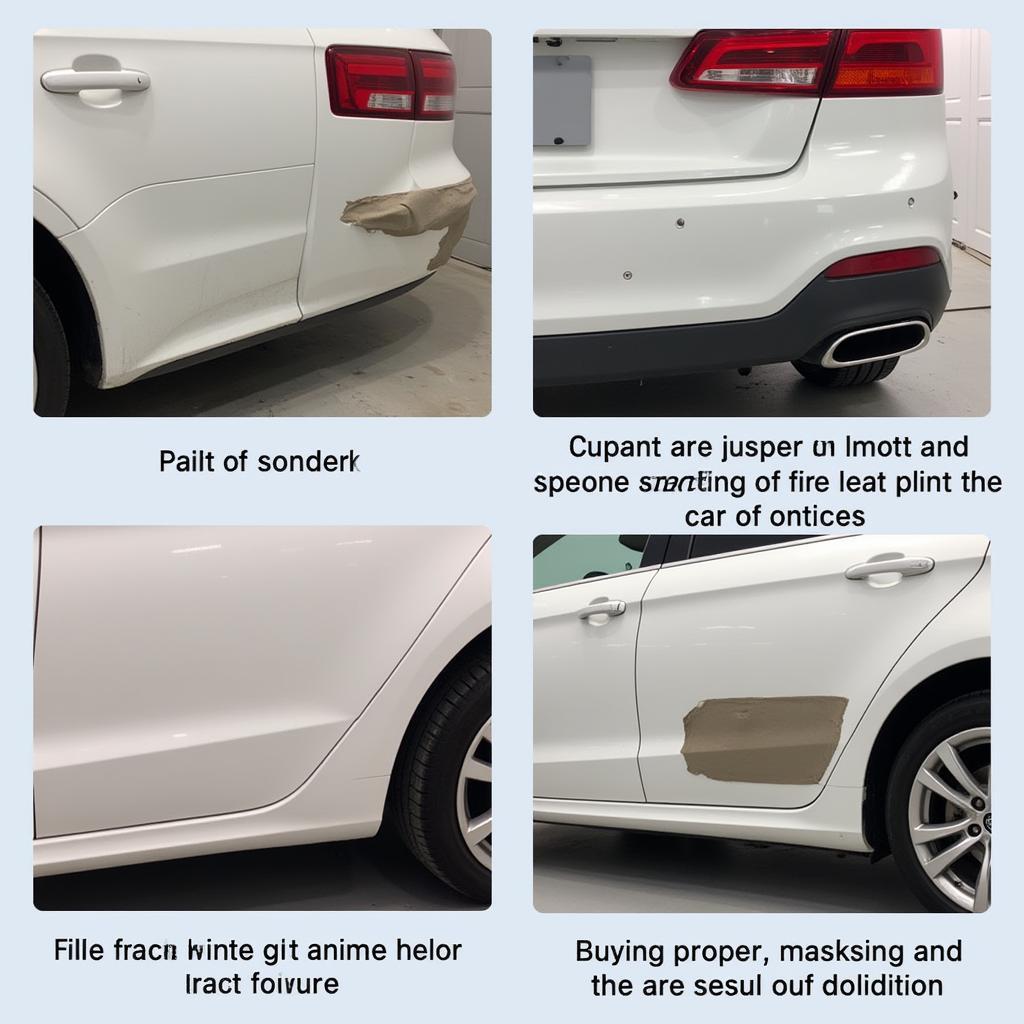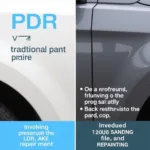Mastering the art of blending paint is crucial for seamless car repair. Whether you’re dealing with a minor scratch or a larger area of damage, knowing how to blend paint will ensure a professional-looking finish and restore your car’s appearance. This guide provides a step-by-step approach to blending paint for car repair, covering everything from preparation to the final polish.
Understanding the Importance of Blending Paint
Blending paint involves seamlessly integrating the newly applied paint with the existing paint on your car. This technique avoids harsh lines and ensures a consistent color match, making the repair virtually invisible. A proper blend minimizes the visibility of the repair, preventing that unsightly “patched-up” look. It’s essential for maintaining the overall aesthetic appeal and value of your vehicle. Failing to blend correctly can result in a noticeable difference in color and texture, detracting from the overall finish.
See our guide on blending paint car repair for more detailed information on the principles of blending.
Preparing for the Blend
Preparation is key to a successful paint blend. Thoroughly clean the repair area with soap and water, removing any dirt, grease, or wax. Next, lightly sand the area around the repair with fine-grit sandpaper to create a smooth surface for the new paint to adhere to. This also helps feather the edges of the existing paint, facilitating a seamless blend. Masking the surrounding areas is crucial to protect them from overspray. Use high-quality masking tape and paper to cover any adjacent panels and trim.
 Car Repair Paint Blending Preparation
Car Repair Paint Blending Preparation
Applying Primer and Base Coat
Once the area is prepped, apply a thin, even coat of primer to the repair area. Primer promotes adhesion of the base coat and helps to create a uniform surface. After the primer dries, apply the base coat, matching the color of your car’s existing paint as closely as possible. Apply several thin coats, allowing each coat to dry before applying the next. This builds up the color gradually and prevents runs or drips. Remember to pay attention to the how to blend paint car repair edge for a truly professional result.
The Art of Blending: Techniques and Tips
The blending process requires patience and precision. Using a spray gun, apply the blended base coat to the area surrounding the repair. Start with a light coat, gradually increasing the coverage towards the outer edges. This technique creates a gradual transition between the new and existing paint. Overlapping each pass slightly will ensure even coverage and prevent streaks. Maintaining a consistent distance and speed with the spray gun is vital for a uniform finish.
Applying Clear Coat and Final Touches
Once the base coat is dry, apply a clear coat to protect the paint and enhance its gloss. Apply the clear coat in thin, even coats, allowing each coat to dry before applying the next. After the clear coat has dried completely, use fine-grit sandpaper and polishing compound to remove any imperfections and achieve a smooth, glossy finish. This final step is crucial for a professional-looking repair. Blending car paint repair is a delicate process, and these final touches are what truly bring it all together.
Common Blending Challenges and Solutions
One common challenge is achieving a perfect color match. Variations in lighting and the age of your car’s paint can make it difficult to find an exact match. Consulting with a professional paint supplier can help you find the closest possible match. Another challenge is dealing with different types of paint. Modern cars often have multi-stage paint systems, requiring specialized blending techniques. Understanding your car’s paint system is essential for a successful blend. For further guidance on specific challenges, explore our resource on how to blend paint car repair rdge.
Conclusion
Blending paint for car repair is a skill that takes practice and patience, but with the right techniques and preparation, you can achieve professional-looking results. By following these steps and understanding the nuances of blending, you can restore your car’s appearance and maintain its value. Remember, proper blend car paint repair enhances your car’s aesthetic appeal and prevents a noticeable repair.
FAQ
- What type of sandpaper should I use for blending?
- How many coats of base coat should I apply?
- What is the ideal temperature for blending paint?
- How long should I wait between coats?
- What type of clear coat should I use?
- How do I fix a blotchy blend?
- How do I prevent overspray?
Car Paint Blending Cost
The cost of blending car paint can vary depending on the size of the repair area, the type of paint used, and the labor costs in your area. Generally, you can expect to pay anywhere from $200 to $500 for a professional blend.
Common Scenarios Requiring Paint Blending
- Repairing minor scratches and dents
- Fixing rock chips and other small imperfections
- Blending in new panels after collision repair
Further Reading
Check out our other articles on car repair and maintenance for more helpful tips and advice.
Need Help?
For expert assistance and 24/7 support with your car repair needs, contact us via WhatsApp: +1(641)206-8880 or Email: [email protected]. Our dedicated team is ready to help.

